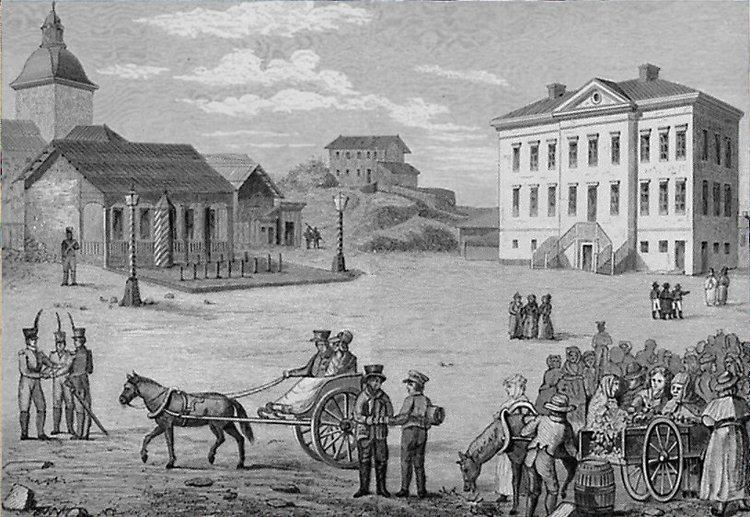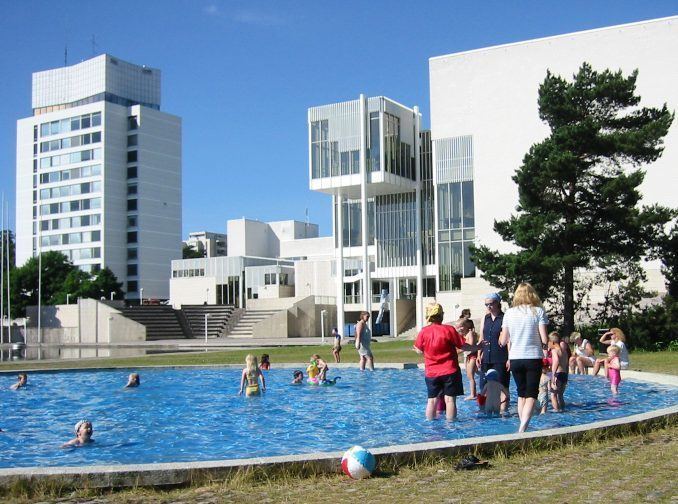Country Population 247,970 (2010) Language spoken Area 528.14 km2 | Region | |
Points of interest EMMA – Espoo Museum of Modern Art, WeeGee house, Nuuksio National Park, Serena Water Park, Lake Bodom | ||
Espoo ( Swedish: , ) is the second largest city and municipality in Finland. The population of the city of Espoo is 265 646 (31.12.2014). It is part of the Capital region and most of its population lives in the inner urban core of the Helsinki metropolitan area, along with the cities of Helsinki, Vantaa, and Kauniainen. Espoo shares its eastern border with Helsinki and Vantaa, while enclosing Kauniainen. The city is on the shore of the Gulf of Finland, in the region of Uusimaa.
Contents
- Map of Espoo
- Nature activities in espoo finland
- Santas cottage korpilampi espoo finland
- History
- Name
- Culture
- References
Map of Espoo
Other bordering municipalities of Espoo are Nurmijarvi and Vihti in the north and Kirkkonummi in the west. The national park of Nuuksio is situated in northwest Espoo.
Nature activities in espoo finland
Espoo encompasses 528 square kilometres (204 sq mi), of which 312 km2 (120 sq mi) is land.
Santas cottage korpilampi espoo finland
Espoo has several local regional centers. Espoo is thus divided into seven major areas (Finnish: , Swedish: ): Vanha-Espoo (with administrative center), Suur-Espoonlahti, Pohjois-Espoo, Suur-Kauklahti, Suur-Leppavaara, Suur-Matinkyla and Suur-Tapiola.
Aalto University is based in Otaniemi, Espoo, along with a thriving science community that includes numerous startups and organizations such as VTT – the Technical Research Center of Finland. Several major companies are based in Espoo, including Nokia Solutions and Networks, Microsoft Mobile, KONE, Neste Oil, Fortum, Orion Corporation and Outokumpu as well as video game developers Rovio and Remedy Entertainment.
The city of Espoo is officially bilingual. The majority of the population, 83.6%, speaks Finnish as their mother tongue, while a minority of 8.3% speaks Swedish. 8% of Espoos population has a first language other than Finnish or Swedish.
History
The first inhabitants in the area arrived about 9,000 years ago. Physical evidence (pollen grains) indicates agriculture from ca. 1000 AD, but there are no historical records. Up to the 13th century, the area was a borderland between the hunting grounds of Finnish Proper and Tavastian Finns, with a sparse population. Immigrants from Sweden established permanent agricultural settlements during the 12th and 13th centuries, assimilating the sparse local Finnish-speaking population. Espoo was a subdivision of the Kirkkonummi congregation until 1486-7. The oldest known document referring to Kirkkonummi is from 1330; Espoo as a subchapter has been dated to the 1380s, although the first document directly referring to Espoo is from as late as 1431. The construction of the Espoo Cathedral, the oldest preserved building in Espoo, marks the independence of Espoo. Administratively, Espoo was a part of Uusimaa. When the province was split to Eastern and Western provinces governed from the Porvoo and Raasepori castles, respectively, the eastern border of the Raasepori province was in Espoo. The 13th century road connecting the most important cities in Finland at that time, the Kings Road passes through Espoo on its way from Stockholm via Turku and Porvoo to Viipuri.

In 1557, King Gustaf Wasa decided to stabilize and develop the region by founding a royal mansion in Espoo. The government bought the villages of Espaby and Mankby (Finnish: Mankki) and transferred the population elsewhere, and built the royal mansion in Espaby. (Mankby was eventually abandoned and was never repopulated.) The royal mansion housed the kings local plenipotentiary (vogt), and collected royal tax in kind paid by labor on the mansions farm. The administrative center Espoon keskus has grown around the church and the Espoo railway station, but the municipality has retained a network-like structure of to the modern day.
In 1920, Espoo was only a rural municipality of about 9,000 inhabitants, of whom 70% were Swedish speaking. Agriculture was the primary source of income, with 75% of the population making their living from farming. Kauniainen was separated from Espoo in 1920, and it gained city rights the same year as Espoo, in 1972.
Espoo started to grow rapidly in the 1940s and 50s. It quickly developed from a rural municipality into a fully-fledged industrial city, gaining city rights in 1972. Due to its proximity to Helsinki, Espoo soon became popular amongst people working in the capital. In the fifty years from 1950 to 2000, the population of Espoo grew from 22,000 to 210,000. Since 1945, the majority of people in Espoo have been Finnish speaking. In 2006, the Swedish speaking inhabitants represented barely 9% of the total population. The population growth is still continuing, but at a slower rate.
Name
The name Espoo probably comes from the Swedish name for the River Espoo, Espa (or Espaa), which in turn comes from the old Swedish word aspe, meaning a border of aspen, and the Swedish word for "river", a, thus "a river bordered by aspen". The name was first mentioned in 1431. The banks of the River Espoo are even today populated heavily with aspen.
Culture

Espoo hosts a Museum of Modern Art called EMMA (Espoo Museum of Modern Art), built in a renovated old print house, the WeeGee house, named after an old book print company Weilin & Goos. The same building hosts also Finlands only Museum of Horology (Finnish: , Swedish: ) and a Toy Museum. Glims Farmstead Museum is also located in the city. The Espoo cultural centre, where numerous concerts and theater performances are held, is located in Tapiola (Swedish: ).
Espoo has several manors two of which are open to the public. The most important is Espoon kartano (Swedish: , Espoo Manor), mentioned first time in 1495, and belonging to the noble Ramsay family since 1756. The current main building dates from 1914, but a mill dates from the 1750s and Finland oldest walved stone bridge from 1777 is on the Kings Road (Finnish: , Swedish: ) which passes by the manor. The main building can be rented for weddings and similar occasions. Guided tours on request for groups. The other manor open to public is Pakankylan kartano, located on the northern shore of Lake Bodom. The manor hosts a restaurant and club rooms, partly with original furniture open to the public, but meant original to Kaisankoti sanatory and old peoples home located on ground of the manor.
The Metal band Children of Bodom comes from Espoo, Finland. They are named after the unsolved murder known as the Lake Bodom murders which took place at Lake Bodom, a lake in northern Espoo in 1960. The bands Norther and Kiuas also come from Espoo.
The educational department takes part in Lifelong Learning Programme 2007–2013 in Finland.
